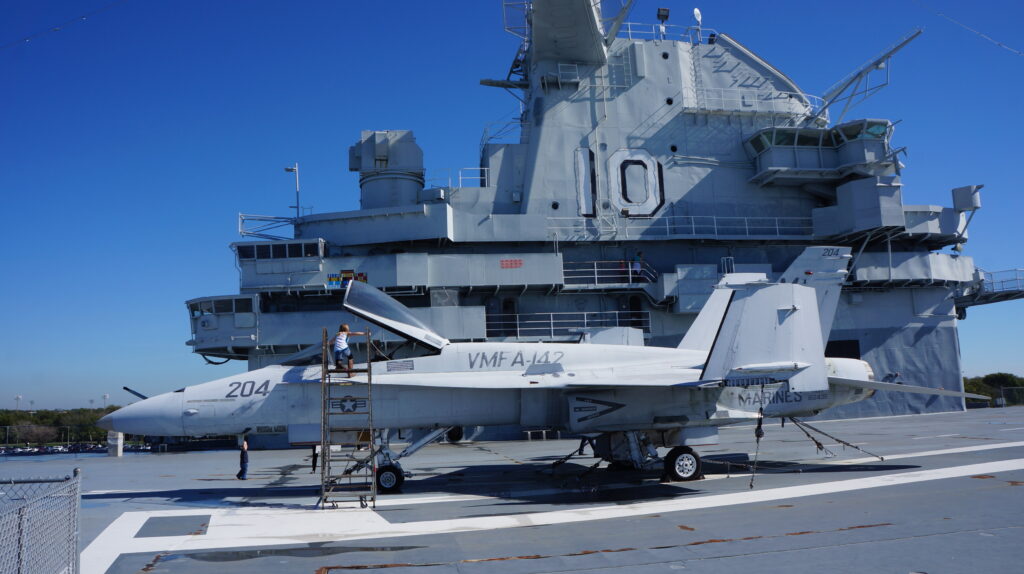CORRECTED: Model of the F-18. It’s an A.
CAPITOL HILL: House defense Republicans really do seem worried that US weapons are so old, new gear so rare and training dollars so short that US troops may soon begin paying the ultimate price for the military’s creaky state after 15 years of war. As with every problem, you need an easily understandable and shocking example of just how bad things are to jumpstart jaundiced and overworked lawmakers.
So, when House Armed Services Committee Chairman Mac Thornberry went to Marine Corps Air Station Beaufort and heard this story, it became part of yesterday’s hearing with Defense Secretary Ash Carter and Chairman of the Joint Chiefs Gen. Joe Dunford.
The only mention at the hearing was about aircraft parts being scrounged from a museum. I asked around today and it turns out an F/A-18 based at Marine Corps Air Station Beaufort that flew in the raid against Libya in 1986 needed a part. The part is no longer made and there were none on hand. Crew and pilots checked the F-18s on display at Beaufort to see if they might find a part. No luck. A lieutenant colonel visiting the USS Yorktown aircraft carrier about two hours away in Charleston, South Carolina. saw an F/A-18 of the same model, a HASC staff member told me today. They scrounged the part from what would appear to be the A D model on the carrier’s deck. (It’s the only F-18 at the Yorktown. And yes, that is a little kid climbing up on Open Cockpit Day!) They got the part, but sadly, it didn’t work.
But HASC had its striking example. “It’s emblematic of the readiness problems across the force,” a committee staffer told me. So, Thornberry laid out his case for a readiness crisis at the hearing:
“Recently, I have heard first-hand from service members who have looked me in the eye and told of:
- “trying to cannibalize parts from a museum aircraft in order to get current aircraft ready to fly the overseas mission assigned (See above);
- getting aircraft that were sent to the boneyard in Arizona back and ready to fly missions;
- pilots flying well below the minimum number of hours required for minimal proficiency and flying fewer training hours than the adversaries they are being sent to meet;
- not having enough senior enlisted people to train and supervise younger ones and those who remain working very long hours day after day;
- service members buying basic supplies, like pens and cleaning supplies and paper towels out of their own pocket, because otherwise it would take three to four months to get them if they could get them at all.
And he hauled out the standard facts service leaders have told Congress for the last few years.
“Aviation units in the Marine Corps cannot meet training and mission requirements. With ‘less than one-third of Army forces at acceptable levels of readiness,’ the Army is ‘not at a level that is appropriate for what the American people would expect to defend them,'” Thornberry said. “‘Less than half [of the Air Force] combat forces are ready for… a high-end fight.’ It is the “smallest, oldest, and least ready [force] across the full-spectrum of operations in our history.’ This testimony across the Services is remarkably consistent, candid, and disturbing.”
Chairman Dunford told Thornberry he was right that readiness is a problem, but he also said the 2017 budget adequately addresses each services’ needs.
The “unstable fiscal environment” created by Congress, combined with an “extraordinarily high operational tempo” is the cause of the readiness worries.
How long will it take to fix this? Dunford offered this grim take. The Army, Navy, and Marine Corps will not repair, train and modernize at a fast enough rate until around fiscal 2020. What about the Air Force, the service that has essentially been at war since Kosovo, you ask? The Air Force won’t have high enough readiness levels to cope with a high end war until fiscal 2028.
So the budget may meet immediate needs to keep those creaky planes flying and Army tankers familiar enough with their beasts to roll and fire, but it doesn’t really meet our readiness needs, does it?
China’s new H-20 stealth bomber ‘not really’ a concern for Pentagon, says intel official
“The thing with the H-20 is when you actually look at the system design, it’s probably nowhere near as good as US LO [low observable] platforms, particularly more advanced ones that we have coming down,” said a DoD intelligence official.



























